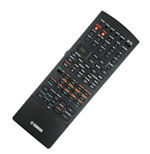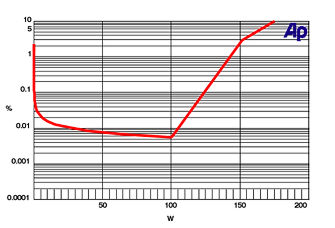The Yamaha RX-V1 Receiver is a top-notch audio device that delivers exceptional sound quality and versatility. With its advanced features and seamless connectivity options, it is the perfect choice for audiophiles in ReportagaKSA seeking a remarkable audio experience. Get ready to immerse yourself in a world of rich sound with the Yamaha RX-V1 Receiver.
Yamaha RX-V1 Receiver Page 2
 The AM/FM tuner allows up to 40 channels to be stored in five subgroups of eight channels each. With a decent antenna, it has fine-sounding, low-noise reception. The remote is a bit less involved than Yamaha's previous offerings. It has both preprogrammed and learning capabilities and can store several macros of up to 10 commands each. One nice touch is that the illumination is limited to the buttons used to control the selected component.
The AM/FM tuner allows up to 40 channels to be stored in five subgroups of eight channels each. With a decent antenna, it has fine-sounding, low-noise reception. The remote is a bit less involved than Yamaha's previous offerings. It has both preprogrammed and learning capabilities and can store several macros of up to 10 commands each. One nice touch is that the illumination is limited to the buttons used to control the selected component. Because of Yamaha's singular approach to surround sound, this receiver is not certified to THX specifications. However, the company has included their own version of Cinema EQ, which compensates for the difference in brightness between a movie theater and your living room. This gives you tremendous control over the system's tonal characteristics, with separate equalization for each channel. Even the headphone output has a surround-simulation program called Silent Cinema that has its own digital equalizer and dynamic-range control, creating an effect similar to Dolby headphones.
 The RX-V1 has 54 different soundfield programs, some of which are used primarily with music while others are best with movies. Within each of these preset soundfields, you can adjust several parameters, including the effect level, liveness, and room size. Many of these programs are based on real-world measurements that Yamaha has taken in venues like the Village Vanguard in New York and the Concertgebouw in Amsterdam. Luckily, I've been to several of the venues, which helped me evaluate the effectiveness of the processing.
The RX-V1 has 54 different soundfield programs, some of which are used primarily with music while others are best with movies. Within each of these preset soundfields, you can adjust several parameters, including the effect level, liveness, and room size. Many of these programs are based on real-world measurements that Yamaha has taken in venues like the Village Vanguard in New York and the Concertgebouw in Amsterdam. Luckily, I've been to several of the venues, which helped me evaluate the effectiveness of the processing.
Yamaha uses LSI chips of their own design operating at an astounding 44 bits, and the results are undeniably impressive. One problem I've often found with this type of processing is that you are, in effect, adding an additional soundfield on top of the one already recorded into the source, so the results can become muddled and indistinct. To test this, I played a fairly dry recording, Jonny Lang's "Good Morning Little School Girl." Sure enough, as I switched from one setting to another, the spaciousness and shape of the soundfield changed quite dramatically. Many of the simulations, such as the Bottom Line and the (now-extinct) Village Gate, were really very realistic, although the somewhat reverberant sound makes me think that the measurements were probably made when the venues were empty. This can be ameliorated to an extent by careful manipulation of the liveness and effect-level controls. Nevertheless, I frequently preferred the original unprocessed version.
For movies, the options are no less astounding. In the standard and enhanced 5.1 and 6.1 matrix modes, the sound was always impressive. The second Austin Powers movie sounded great using the enhanced 6.1 matrix, with a wide, open soundstage and excellent dynamics. As with music, the results achieved when adding the DSP were somewhat of a mixed bag. Often times, a setting that sounded great during a big, loud action sequence would sound overly reverberant during a quieter scene with intimate dialogue. In the studio, a movie's sound designer can tailor the soundfield for each scene, whereas this receiver uses a one-size-fits-all solution with unpredictable results.
With 110 watts per channel for each of the six main speakers and 35 more for each front surround speaker, there's plenty of power for most applications. Even hard-hitting dynamic material like the final battle from the DTS version of Saving Private Ryan never left me wanting additional power, although using the M&K MX-350THX subwoofer added substantial impact that the Yamaha couldn't coax from my Snell Type As.
Many people are likely to balk at the thought of spending $3,300 on a receiver; however, if Yamaha were to dump the power-amplifier section and sell this simply as a pre/pro, it would still be an excellent value. Whether it's the right product for you will depend somewhat on your ability to find room for the plethora of speakers needed to get the best results. When fully loaded, this receiver is so flexible and powerful that I'm sure anyone could find a setting that would live up to their highest expectations.
Highlights
• A technical tour de force
• Extremely flexible connections
• Demands a lot of speakers and the right room
HT Labs Measures: Yamaha RX-V1 Receiver 
The above measurement shows that the RX-V1's left amplifier channel, with two channels driving 8-ohm loads, began clipping at 0.0056% distortion and 100.1 watts. The amp reaches 0.1% distortion at 123.8 watts and 1% distortion at 142.7 watts, as shown above. Into 4 ohms, the amplifier begins clipping at 195.5 watts and reaches 0.1% distortion at 217.7 watts and 1% distortion at 235.8 watts.
The analog frequency response was +/- 0.11 decibels from 20 hertz to 20 kilohertz. The response dropped to 0.16 dB at 10 Hz and to 0.53 dB at 50 kHz. Crosstalk was - 80.1 dB from left to right at 1 kHz and - 80.9 dB from right to left at 1 kHz. THD+N from the amp was less than 0.0058% at 1 kHz, driving an 8-ohm load at 2.83 volts.
From the Dolby Digital input to the loudspeaker outputs, the left, center, and surround channels are all flat, +0/- 0.51 dB from 20 Hz to 20 kHz. From the Dolby Digital input to the line-level output, the LFE channel is +0.03 dB at 20 Hz and reaches the 3-dB down point at 89 Hz and the 6-dB down point at 103 Hz, normalized to 40 Hz.— AJ

- Log in or register to post comments































































